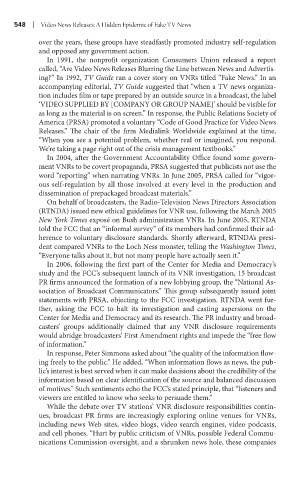Page 569 - Battleground The Media Volume 1 and 2
P. 569
| V deo News Releases: A H dden Ep dem c of Fake TV News
over the years, these groups have steadfastly promoted industry self-regulation
and opposed any government action.
In 1991, the nonprofit organization Consumers Union released a report
called, “Are Video News Releases Blurring the Line between News and Advertis-
ing?” In 1992, TV Guide ran a cover story on VNRs titled “Fake News.” In an
accompanying editorial, TV Guide suggested that “when a TV news organiza-
tion includes film or tape prepared by an outside source in a broadcast, the label
‘VIDEO SUPPLIED BY [COMPANY OR GROUP NAME]’ should be visible for
as long as the material is on screen.” In response, the Public Relations Society of
America (PRSA) promoted a voluntary “Code of Good Practice for Video News
Releases.” The chair of the firm Medialink Worldwide explained at the time,
“When you see a potential problem, whether real or imagined, you respond.
We’re taking a page right out of the crisis management textbooks.”
In 2004, after the Government Accountability Office found some govern-
ment VNRs to be covert propaganda, PRSA suggested that publicists not use the
word “reporting” when narrating VNRs. In June 2005, PRSA called for “vigor-
ous self-regulation by all those involved at every level in the production and
dissemination of prepackaged broadcast materials.”
On behalf of broadcasters, the Radio-Television News Directors Association
(RTNDA) issued new ethical guidelines for VNR use, following the March 2005
New York Times exposé on Bush administration VNRs. In June 2005, RTNDA
told the FCC that an “informal survey” of its members had confirmed their ad-
herence to voluntary disclosure standards. Shortly afterward, RTNDA’s presi-
dent compared VNRs to the Loch Ness monster, telling the Washington Times,
“Everyone talks about it, but not many people have actually seen it.”
In 2006, following the first part of the Center for Media and Democracy’s
study and the FCC’s subsequent launch of its VNR investigation, 15 broadcast
PR firms announced the formation of a new lobbying group, the “National As-
sociation of Broadcast Communicators.” This group subsequently issued joint
statements with PRSA, objecting to the FCC investigation. RTNDA went fur-
ther, asking the FCC to halt its investigation and casting aspersions on the
Center for Media and Democracy and its research. The PR industry and broad-
casters’ groups additionally claimed that any VNR disclosure requirements
would abridge broadcasters’ First Amendment rights and impede the “free flow
of information.”
In response, Peter Simmons asked about “the quality of the information flow-
ing freely to the public.” He added, “When information flows as news, the pub-
lic’s interest is best served when it can make decisions about the credibility of the
information based on clear identification of the source and balanced discussion
of motives.” Such sentiments echo the FCC’s stated principle, that “listeners and
viewers are entitled to know who seeks to persuade them.”
While the debate over TV stations’ VNR disclosure responsibilities contin-
ues, broadcast PR firms are increasingly exploring online venues for VNRs,
including news Web sites, video blogs, video search engines, video podcasts,
and cell phones. “Hurt by public criticism of VNRs, possible Federal Commu-
nications Commission oversight, and a shrunken news hole, these companies

